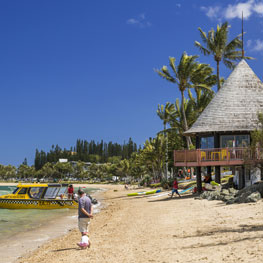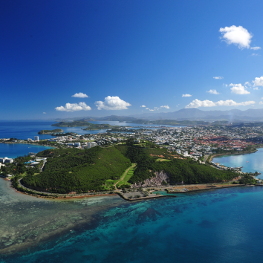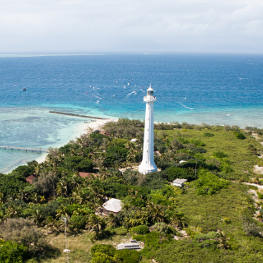Located at Anse Vata bay, the Lagoons Aquarium in Nouméa hosts a variety of corals, fish, crustacean and marine mammals, with some demonstrating the endemism of the New Caledonian aquatic wildlife. Entirely renovated in 2007, the aquarium is today one of the most popular tourist attractions in Nouméa.
The Nouméa Aquarium was founded by Dr. René Catala, a renowned biologist, and his wife Ida, in 1956. It quickly gained international recognition thanks to many discoveries made by Dr. Catala and his team. In 1957, he discovered the fluorescence of certain corals and gave his name to one of its species, which can be observed at the museum.
Discover the Aquarium
Voir plus-
![An urban lagoon]()
An urban lagoon
The Aquarium des Lagons is the second major attraction for marine wildlife lovers. With its multiple different tanks, you can admire a collection of phosphorescent corals unique in the world. The aquarium also boasts a garden featuring a turtle pool. Throughout the year, the aquarium organizes very popular “nocturnals.” They allow you to observe the night-time behavior of the fish and to attend fun awareness-raising workshops on conservation of the lagoon.
-
At the heart of biodiversity
Thanks to a circuit taking water directly from the Lemon Bay, the Nouméa aquarium presents the organisms in their natural habitat, with natural lighting. The visit is organized into different zones. Fresh water, with the numerous “inhabitants” of the territory's rivers and lakes: crustaceans, giant shrimps, eels, etc... The sea-grass beds are like underwater meadows attracting many species such as the famous Dugongs and green turtles as well as corals, sponges and starfish. Mangroves which are numerous in New Caledonia are shown with a system reproducing tides, needed by the roots of its trees which demonstrate the fragility of this environment that must be preserved. All the lagoon fauna is obviously also present, from the clownfish to the damselfish, angel fish, parrots, moray eels, octopuses, as well as the flora, with a myriad of multicolored anemones, each more radiant than the next!
-
Fluorescent nautilus and corals
For 60 million years, nautiluses have populated deep seas. Shown in conditions close to their natural habitat, these strange mollusks perform their unusual ballet for visitors. Also spectacular, are fluorescent corals you can discover in the dark. Exposed to ultraviolet lights they reveal their incredible colors and lights.
-
![A health care center]()
A health care center
True to its commitment to the preservation of the marine environment and the particularly rich ecosystems of New Caledonia, whose lagoons are classified as UNESCO world heritage, the aquarium includes a health care center. From the first day, it has been treating sick animals, especially marine turtles, in suitable health care facilities.







